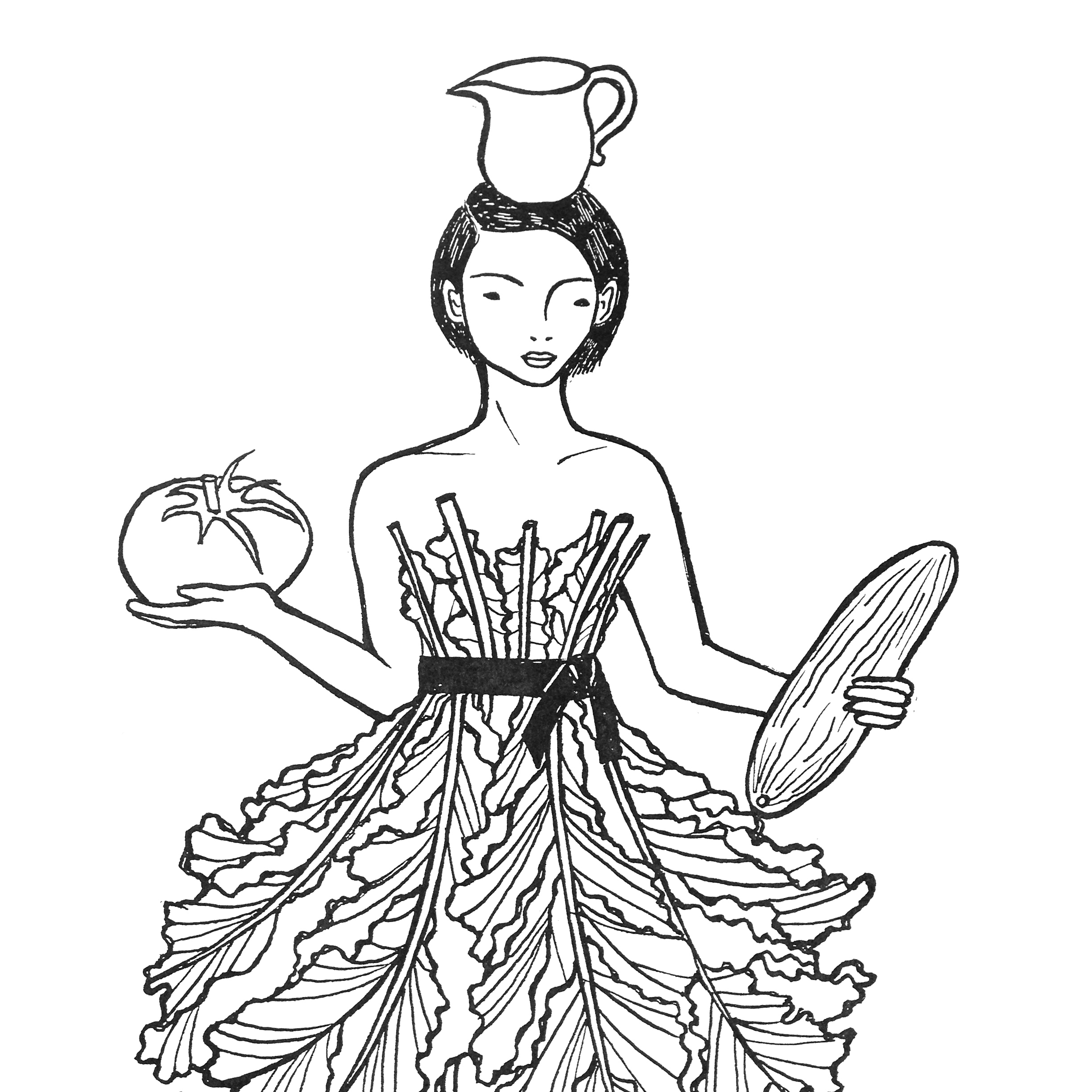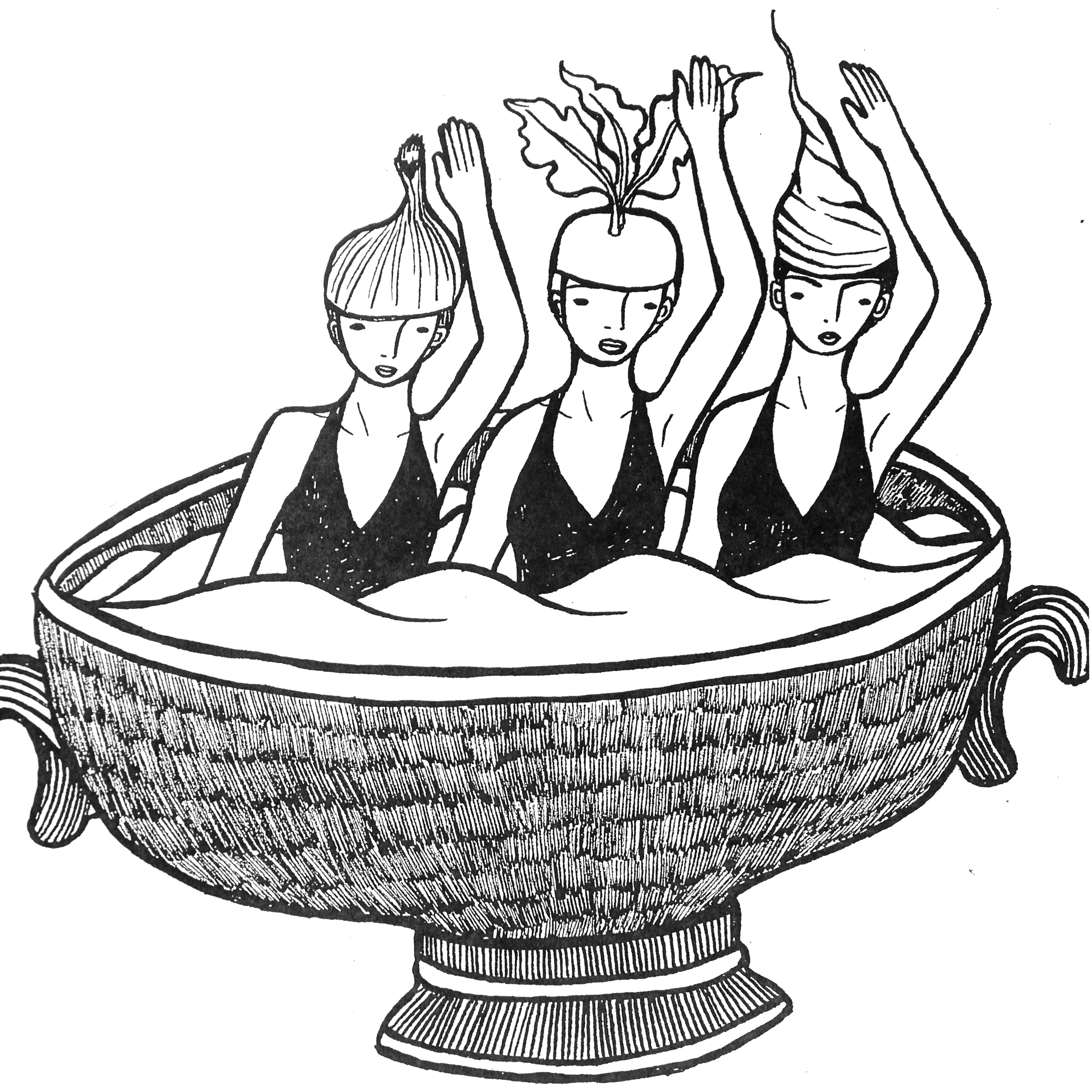the cookbook
by sanae

When I first started cooking I also began to write down the recipes. I was still learning how to write with a fountain pen between the draconian lines of a clairefontaine notebook. My fingers were nimble from years of sewing and knitting and woodworking at a Rudolf Steiner school in Australia, but my mind was too distracted for cursive writing that needed to fit on six different lines. Every letter was a struggle. I was slow, but wildly determined. I had arrived to France at age twelve, after a long hiatus, and I stayed awake until midnight rewriting my day’s lessons. I couldn’t write quickly enough in class, I didn’t have any friends yet, and so in my closet-sized bedroom I wrote until my hands were sore. I took breaks, looking through the window at the church looming over our apartment building. As a result, writing recipes was a slow process. I wrote four or five recipes, and then I tired. There was a recipe for vanilla cake, one for a niçoise salad. My handwriting was tiny and compact, furiously cursive. There were illustrations for each ingredient. A small orange carrot, little dots to indicate flour, a spoon. This was my first foray into recipe writing.
This summer Sarah and I decided to make a cookbook together. Our close friend was getting married in November and we couldn’t think of a better gift. We both love to cook and write, and we thought the task would be simple enough. Over a dinner of green curry and lemongrass-fried rice, we discussed the first outlines of the project. We decided the book would be divided into categories: breakfast, dips and sauces, stews and soups, salads, meat and fish, grains and vegetables, desserts, and eating alone. I still remember the excitement of that first night: we sat cross-legged on my futon typing a list of our favorite recipes, some our own creations, others from blogs and cookbooks, and we reminisced about those nights in college when our kitchen turned into a chugging factory, producing apple pies, scones, and failed chocolate babkas. We had shared a kitchen for one semester, and we both had vivid memories of each other’s cooking. I recalled Sarah’s intense tuna-tomato spaghetti sauce and her garlic mashed potatoes and the midnight chocolate espresso cake she made for my birthday. She had skipped class to bake it. I asked my artist and writer friend Elena Megalos to draw the illustrations. I knew she would create the strangest, most magical and marvelous drawings.
The book took longer than we anticipated. We added and cut recipes. We labored over phrasing, trying to anticipate what kind of guidance our friend might need for recipes that felt like second nature to us. We laughed when we noticed that the cookbook was turning into a peculiar combination of our multicultural selves: French, Japanese, Tunisian, Vegan, and Vegetarian… If some recipes called for hunks of cheese the size of our elbows, others called for almond milk and chia seeds. There was no logic, no underlying philosophy, other than the simple fact that we swore by these recipes, we had made them over and over again, and we got hungry just by thinking about them.
We wrote short introductions for each section. We read and reread. Soon enough we were a week from the wedding. I found myself at the Writing Center with Elena. Between classes, teaching, and student conferences, Elena and I bought thick paper and hid in the back by the copier. We cut paper, photocopied, assembled. Elena was the expert, handing me pages by the dozen as I printed out more. Colleagues glanced over our shoulders to see Elena’s drawings. They were curious. The hummus drawing was a hit. And then it was finished: 127 pages, over a hundred eccentric recipes, a heavy tome ready to be bound. Perhaps because it was our first, or because we felt a little tired from writing and also immensely proud, we called it “The Cookbook.”
Here I share a few recipes from our beloved book (it now rests in our friend’s Lower East Side kitchen), for your pleasure.

Almond milk sweetened with dates
(From Kirsten Saracini — there is always a fresh jar sitting in our fridge)
Let 1 cup of almonds soak in water for 8-12 hours, in a bowl, in your kitchen.
Discard soaking water.
Then blend:
1 cup soaked almonds
3 cups water
2 dates (seeds out!)
vanilla to taste
cinnamon (optional, I usually add it right before drinking)
Keeps for ~3 days in the fridge.

Parsley hummus
(Adapted from Ali Souli, as he never measures anything)
Ingredients:
1 can of cooked garbanzo beans, drained and rinsed
3-4 garlic cloves, crushed
3 tbsp tahini
1 ½ tsp cumin
1 tsp paprika
Handful of chopped parsley
¼ cup olive oil, plus more for garnish
1 lemon, juice and zest
Salt to taste
Directions:
In a food processor, blend chickpeas and garlic till smooth. Add tahini and blend to combine. Add cumin, lemon juice and zest, blending again. With the processor running, slowly drizzle olive oil till the hummus is smooth and creamy, but not runny. Add parsley, pulsing to incorporate. Taste and add salt, and more cumin or lemon juice if necessary. Serve at room temperature, and garnish with more parsley, a bit of olive oil and paprika.

Orange, olives, pistachio salad
I like the colors of this dish. Sometimes I use a blood orange if I can find one. The combination of ingredients is so simple and light, the citrus pairs well with the saltiness of olives and crunch of toasted pistachios. I use a peppery olive oil from Spain for an extra spark. — Sanaë
Ingredients:
2 oranges
Five to six black olives
Pistachios
Sea salt, pepper, extra virgin olive oil
Directions:
Peel oranges and leave them whole. Slice into thin pieces. Spread them out onto a flat, round plate. Tear black olives into small pieces and scatter onto the oranges. Toast unsalted pistachios in a pan over medium heat until fragrant. Careful they don’t burn, keep stirring until ready! Chop them up and sprinkle over the oranges. Sprinkle salt, crack some pepper, and drizzle with your finest olive oil. Serve as an appetizer.

Mediterranean ocean sink pasta
This is the rustic pasta that I ate as a child, and that I consumed in large quantities in college — it’s cheap, you probably already have the ingredients, and it’s good. The taste is distinctly ocean-y and salty, and you can take out or add ingredients as you please. A teaspoon of chopped preserved lemon would be a welcome addition, for example. — Sarah
Ingredients:
1 onion, roughly chopped
3 cloves of garlic, chopped
1 large can of whole, peeled plum tomatoes
2 tbsp tomato paste
Olive oil
Sea salt and pepper
2 whole bay leaves
1 tbsp herbes de Provence
1 tsp red pepper flakes (optional)
1 can of tuna fish, packed in olive oil (Cento is my preferred brand)
2 tbsp capers
⅓ cup pitted kalamata olives, coarsely chopped
Large handful of flat-leafed parsley, chopped
Pasta (I find bowtie holds the sauce best)
Directions:
Bring a large pot of water to a boil — salt liberally, it should taste like the sea. Meanwhile, coat a large sauté pan with olive oil. Reduce the heat to medium low, add onions, and sauté till translucent. Add garlic and sauté for 30 seconds, till fragrant. Add tomato paste, bay leaves, herbes de Provence and pepper (if using), stirring for about 1 to 2 minutes. Add the canned tomatoes and their juices, crushing the tomatoes with the back of a spoon. Let simmer for 25 minutes.
Add pasta to the water, and cook al dente, following the instructions on the packaging. Drain and set aside, reserving ½ cup of pasta water. Add canned tuna, drained of most its oil, olives and capers to the sauce, and cook for 1-2 minutes. Taste and add salt and pepper. Turn off the heat, and add the parsley to the sauce, reserving some for garnish. Add the pasta to the pan, and thoroughly combine everything. Serve on heated plates, garnishing with reserved parsley and a smattering of Parmesan.

Akiko’s potato salad
Ingredients:
4-5 medium sized potatoes (pick the flavorful, sweet, in-season kind), diced into cubes
1 small cucumber, sliced thinly
1/4 onion, finely diced
Extra virgin olive oil
Sea salt
Juice from ½ lemon
Directions:
Place the diced onion in a small bowl and cover with cold water. Let sit for 15 minutes. This removes some of the strong flavor. Rinse, strain and set aside.
In another small bowl, combine cucumber with a pinch of salt and mix with your fingers until the cucumber slices are covered with salt. Let sit for 15 minutes. They will release liquid during this time. Squeeze excess water with your fingers and set the cucumbers aside.
In the meantime, bring a large pot of water to boil. Salt generously. Add the potatoes and cook until tender. You don’t want the potatoes to be hard at all; they should be borderline soft. Once cooked, drain the potatoes.
In a large bowl, add the steaming hot potatoes, drizzle olive oil, add a large pinch of salt, and the lemon juice. Stir. Taste. You might add more olive oil and salt, but the proportions are up to you. I usually go heavy on the oil, especially if it’s a good kind, because it adds a delicious, sharp flavor to the potatoes. At this point the potatoes will hold their shape but be creamy at the edges so a potato-olive oil “cream” coats them and holds the “salad” together. Allow for the potatoes to cool down—then add the onions and cucumbers, stir, and serve as a side.

Avocado, sesame oil, chili, soy sauce toast
This is best eaten alone on a weeknight, standing in your kitchen and sipping a glass of wine.
Ingredients:
½ avocado
1 tsp. toasted sesame oil
½ tsp. chili paste (or more, depending on taste)
Soy sauce
1 slice of fresh bread
Directions:
Coarsely mash avocado with sesame oil and chili paste. Add a dash of soy sauce, taste, and add more if you like a saltier avocado. Spread on a slice of freshly toasted bread.

